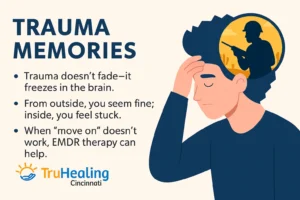Some nights, it isn’t the present that hurts. It’s the past.
A single sound, smell, or phrase can open a door you’ve been trying to keep closed for years.
Maybe it’s an image that flashes behind your eyes when you’re trying to fall asleep. Maybe it’s a specific day you can’t stop replaying—no matter how hard you’ve tried to bury it. Maybe it’s the guilt that lives just beneath your ribs, whispering that you should be over this by now.
You don’t want to die. You just don’t want to feel like this anymore.
At TruHealing Cincinnati, we understand that place—the space between exhaustion and survival, between not wanting to die but not wanting to keep carrying the same pain. Many people who find healing here come to us with one thing in common: memories that won’t let them rest. And for those memories, EMDR therapy can become a lifeline.
When Your Brain Won’t Let Go
Trauma doesn’t always look like chaos. Sometimes it looks like functioning well enough on the outside while crumbling inside.
You might have a steady job, a family, a schedule that keeps you moving—but the quiet moments undo you. Your body doesn’t know that the danger is over. It still reacts like it’s happening right now.
That’s because trauma doesn’t fade with time; it freezes. When something unbearable happens and your brain can’t process it safely, it tucks the memory away—unprocessed, unhealed, unfinished. Later, that same memory resurfaces as panic, nightmares, or numbness.
Trauma is the body remembering what the mind tried to forget.
If you’re living with trauma, it’s not weakness. It’s your brain trying—desperately—to protect you. EMDR therapy helps that same brain realize it doesn’t have to fight anymore.
When “Move On” Doesn’t Work
You’ve probably heard it: “Just move on.” “Let it go.” “The past is the past.”
But no matter how many times you repeat those words, something inside you still clenches.
You’ve tried the distractions—working longer hours, staying busy, drinking, numbing out. Maybe you’ve even gone through addiction treatment before. But when the noise fades, the memories return.
Healing isn’t about willpower. It’s about safety.
Your brain can’t move forward until it believes you’re safe enough to look back.
That’s what EMDR therapy creates: safety inside your own mind. Safety to look at what hurt you without collapsing under it. Safety to finally let your body know it survived.
What Happens in EMDR Therapy
EMDR stands for Eye Movement Desensitization and Reprocessing. It sounds clinical, but at its heart, it’s simple: it helps your brain finish what trauma interrupted.
When you experience trauma, your memories get stuck—like files that never finished downloading. EMDR therapy helps “unstick” them through gentle bilateral stimulation, often by moving your eyes side to side, hearing alternating tones, or feeling light taps on each hand.
During that process, your therapist will guide you to recall specific memories in short, manageable pieces—while helping your brain process them with new perspective and emotional distance.
You don’t relive the trauma. You revisit it safely.
You don’t erase your memories. You reclaim them.
Many people describe EMDR as the first time they could remember something painful without their whole body reacting like it was happening again.
It’s not magic—but it feels close to it.
What Healing Can Feel Like
Healing isn’t loud. It doesn’t come in sudden bursts of enlightenment. It often starts quietly, in the smallest shifts:
- You wake up one morning and realize you didn’t have a nightmare.
- Someone mentions the past, and your heart doesn’t race.
- You feel a sense of calm in a place that used to feel like a battlefield.
For people who’ve lived with trauma, those small moments are monumental. They’re signs that your brain is re-learning safety.
You start to feel present again. You start to trust your own reactions. You begin to believe that the worst thing that ever happened to you isn’t the whole story anymore.
That’s the work of EMDR therapy—not to make you forget, but to remind you that your life is bigger than what hurt you.

When You Don’t Want to Die, But Don’t Know How to Live
There’s a quiet kind of hopelessness that doesn’t show up in crisis lines or hospital charts. It’s the exhaustion of living every day with a past that never loosens its grip.
If you’ve thought about ending your life, you might not want death itself—you just want rest. You want peace from the replaying, the fear, the shame.
You’re not broken for feeling that way.
You’re human.
Wanting relief isn’t the same as wanting to disappear.
This is where therapy, especially EMDR, can become something more than treatment—it can become a way back to yourself. You don’t have to promise forever. You just have to take one small step toward trying again.
What If You’ve Tried Therapy Before?
Maybe you’ve seen therapists before, told your story, and left feeling worse. That’s okay. Many trauma survivors stop therapy because traditional talk therapy feels too painful or too slow.
EMDR is different. It doesn’t force you to explain everything in detail. You don’t have to relive it to heal it. You just have to let your brain finish processing what it already remembers.
If you’ve walked away from therapy in the past, that doesn’t mean you failed—it means your nervous system wasn’t ready for that kind of work. You can start again, gently, on your own timeline.
Whether you’re here in Cincinnati or looking for EMDR therapy near Indianapolis, Indiana, we’ll meet you where you are—not where someone else thinks you should be.
Healing Takes Time—But You’re Already Doing It
Even reading this is an act of hope. It means part of you still believes there might be more to life than pain.
Healing through EMDR doesn’t happen all at once. There may still be triggers, tears, and moments where you want to quit. But over time, something shifts. You begin to experience yourself not as a collection of broken moments, but as someone capable of calm, connection, and courage.
It doesn’t mean the memories vanish—it means they stop owning you.
At TruHealing Cincinnati, we use EMDR therapy as part of a trauma-informed care approach that supports people dealing with both trauma and addiction. Because when your mind and body finally start working with each other again, the relief isn’t just emotional—it’s physical.
You’re Still Here. That’s the Beginning.
You don’t have to have perfect hope to start healing. You don’t even have to believe it will work. You just have to be curious enough to try.
Because maybe—just maybe—the memories that once haunted you can become something else: proof of what you’ve survived, not reminders of what you’ve lost.
Even in the quiet, even in the pain, your life is still unfolding. And you still belong in it.
FAQs About EMDR Therapy and Trauma Healing
What is EMDR therapy used for?
EMDR therapy helps people recover from traumatic experiences, PTSD, abuse, or painful memories that keep resurfacing. It’s also effective for people struggling with anxiety, depression, or addiction rooted in unresolved trauma.
How is EMDR different from traditional talk therapy?
You don’t need to retell your trauma in detail. EMDR focuses on how your brain stores memories and helps it reprocess those experiences safely. It works at a neurological level, not just through conversation.
Can EMDR therapy help with suicidal thoughts?
Yes—indirectly. While EMDR isn’t a crisis intervention, it reduces the emotional intensity of trauma that often drives suicidal ideation. By helping your body feel safer, your thoughts can begin to calm too.
Is EMDR safe if I’m in addiction recovery?
Absolutely. EMDR is often used in addiction treatment to address the trauma beneath substance use. Processing that trauma can reduce relapse risk and help you feel emotionally regulated without needing substances to cope.
What if I’m afraid of what will come up in therapy?
That fear is valid. EMDR therapists are trained to move slowly and ensure you feel grounded and safe throughout the process. You’ll never be pushed beyond what you can handle.
How long does EMDR therapy take to work?
It varies for each person. Some clients feel relief within a few sessions; others take longer. The process moves at your pace—because real healing can’t be rushed.
Can I start EMDR if I don’t live in Cincinnati?
Yes. TruHealing provides support across the region, including for those looking for EMDR therapy near Springfield, Ohio or surrounding areas. You can reach out to discuss local or virtual options.
You Deserve Peace—Not Just Survival
You’ve carried your memories long enough. Let someone help you carry them differently.
Call (888) 643-9118 or visit our EMDR therapy page to learn how trauma-focused care at TruHealing Cincinnati can help you finally find quiet, safety, and lasting relief.


